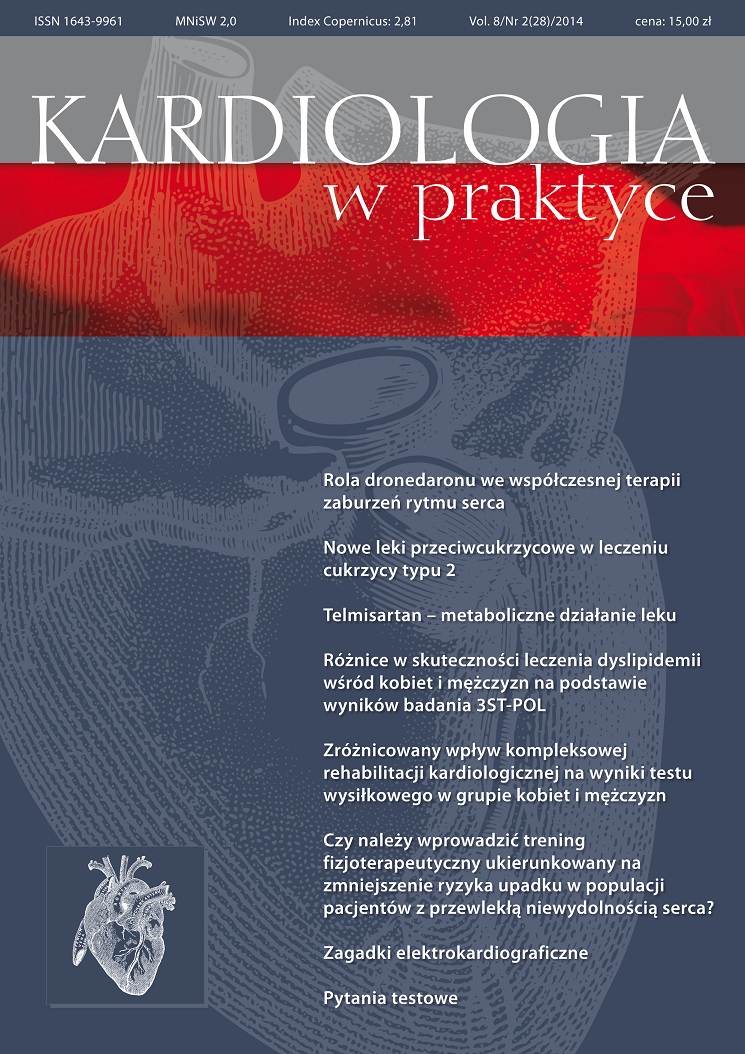Zróżnicowany wpływ kompleksowej rehabilitacji kardiologicznej na wyniki testu wysiłkowego w grupie kobiet i mężczyzn Artykuł oryginalny
##plugins.themes.bootstrap3.article.main##
Abstrakt
Celem badania była ocena wpływu różnych modeli II etapu rehabilitacji kardiologicznej na obciążenie serca, czas trwania testu wysiłkowego i szybkość powrotu spoczynkowej czynności serca oraz porównanie tych wskaźników w grupie kobiet i grupie mężczyzn.
Pobrania
##plugins.themes.bootstrap3.article.details##

Utwór dostępny jest na licencji Creative Commons Uznanie autorstwa – Użycie niekomercyjne – Bez utworów zależnych 4.0 Międzynarodowe.
Copyright: ? Medical Education sp. z o.o. This is an Open Access article distributed under the terms of the Attribution-NonCommercial 4.0 International (CC BY-NC 4.0). License (https://creativecommons.org/licenses/by-nc/4.0/), allowing third parties to copy and redistribute the material in any medium or format and to remix, transform, and build upon the material, provided the original work is properly cited and states its license.
Address reprint requests to: Medical Education, Marcin Kuźma (marcin.kuzma@mededu.pl)
Bibliografia
2. Taylor R., Brown A., Ebrahim S.: Exercise-based rehabilitation for patients with coronary heart disease: systematic review and meta-analysis of randomized controlled trials. Am. J. Med. 2004; 116: 682-692.
3. Dylewicz P., Jegier A., Piotrowicz R. et al.: Kompleksowa rehabilitacja kardiologiczna. Stanowisko Komisji ds. Opracowania Standardów Rehabilitacji Kardiologicznej PTK. Folia Cardiol. 2004; 11(supl. A): 1-48.
4. 1994 Heart and stroke facto statistic. American Heart Association. Dallas 1993.
5. O?Connor G., Buring J., Yusuf S.: Anoverview of randomised trias of rehabilitation with exercise after myocardial infarction. Circulation 1989; 80: 234-244.
6. Thompson D., Bowman G., Kitson A. et al.: Cardiac rehabilitation services in England and Wales: a national survey. Int. J. Cardiol. 1997; 59: 299-304.
7. Bjarnson-Wehrens B., Predel H., Graf C.: Ambulante kardiale Rehabilitation der phase II ? Kolner Model ? einschliesslich der Ergebnisse drei Jahre nach Abschluss der Rehabilitation. Herz 1999; 24: 9-23.
8. Caras D., Wenger N.: Exercise rehabilitation of women with coronary heart disease. J. Myocard. Ischem. 1993; 5: 42-54.
9. Zdrenghea D., Sitar-Tăut A., Pop D.: Comparison between heart rate variability and recovery in ischemic patients. Rom. J. Intern. Med. 2007; 45: 171-175.
10. Myers J., Hadley D., Oswald U. et al.: Effects of exercise training on heart rate recovery in patients with chronic heart failure. Am. Heart J. 2007; 153: 1056-1063.
11. Legramante J., Iellamo F., Massaro M. et al.: Effects of residential exercise training on heart rate recovery in coronary artery patients. Am. J. Physiol. Heart Circ. Physiol. 2007; 292: 510-515.
12. Giallauria F., Lucci R., Pietrosante M. et al.: Exercise-based cardiac rehabilitation improves heart rate recovery in elderly patients after acute myocardial infarction. J. Gerontol. B. Sci. 2006; 61: 713-717.
13. Tiukinhoy S., Beohar N., Hsie M.: Improvement in heart rate recovery after cardiac rehabilitation. J. Cardiopulm. Rehabil. Prev. 2003; 23: 88-89.
14. Cannistra L., Balady G., O?Malley C.: Coparison of the clinical profile and outcome of women and men In cardiac rehabilitation. Am. J. Cardiol. 1992; 69: 1247-1279.
15. Anne Maria Möller-Leimkühler: Gender differences in cardiovascular disease and comorbid depression. Dialogues Clin. Neurosci. 2007; 9: 71-83.
16. Bjarnason-Wehrens B., Grande G., Loewel H.: Gender-specific issues in cardiac rehabilitation: do women with ischaemic heart disease need specially tailored programmes? Eur. J. Cardiovasc. Prev. Rehabil. 2007; 14: 163-171.
17. Temfemo A., Chlif M., Mandengue S.: Is there a beneficial effect difference between age, gender, and different cardiac pathology groups of exercise training at ventilatory threshold in cardiac patients? Cardiol. J. 2011; 18(6): 632-638.
